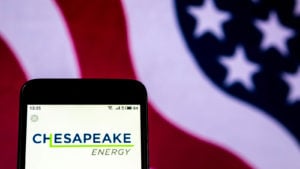On Feb. 9, Chesapeake Energy (NASDAQ:CHK) came out of Chapter 11 bankruptcy. Now, CHK stock looks like a bargain. The company has no debt except for recently raised five-year notes for $1 billion.

However, after receipts from warrants that are now in-the-money, the remaining net debt is only $71 million, according to an analyst writing in Seeking Alpha.
More importantly, though, management now seems to have become quite serious about generating free cash flow (FCF). Chesapeake even says its FCF will be “sustainable.”
For example, in its initial press release upon exiting bankruptcy, Chesapeake said it expects to generate large amounts of FCF — $2 billion on a cumulative basis over the next five years.
Why CHK Stock Is a Bargain
CHK stock now has 100 million shares. Using its Feb. 16 price of $43.60, Chesapeake’s market capitalization (before any of the warrants are exercised) is $4.36 billion. The $2 billion in FCF averages out to $400 million per year over five years.
Therefore, an investor who intends to hold CHK stock for five years will make a very high FCF yield. For example, $400 million divided by $4.36 billion in market value works out to 9.17% per year on average.
That, in essence, is why the stock is a bargain. Again, this assumes that the investor holds Chesapeake for the full five years and that the company is able to produce that $2 billion in FCF over the same period. If it is able to do that, you will likely see management initiate either a dividend, a share buyback program or both.
This also assumes — as you might have guessed — that oil and gas prices stay relatively high over the next several years. They need to stay high enough for the company to produce these FCF levels. In that vein, Chesapeake Energy also released a very detailed operations presentation on Feb. 9.
The company has become a low-cost operator focused mainly on natural gas in Pennsylvania’s Marcellus shale and the Haynesville region of Louisiana (Slide 12). That shows that Chesapeake now has a cost per barrel of oil equivalent (BOE) of between $13.60 to $15.05.
The difference between those costs (plus admin and capex) and the market price of oil equivalent (currently over $59 per barrel) accrues to free cash flow. In other words, it is making a very good margin that will underline the “sustainable” nature of its FCF yield projections.
What Will Happen
At first glance, it appears that the company really does want to be a much more conservative and “sustainable” FCF generator, whatever that means. I’m keeping that word — “sustainable” — in quotes, since there are no guarantees with a commodity producer.
For example, in the appendix to the presentation, Chesapeake points out that it has hedged or “locked in 75% of forecasted volumes for 2021” (Slide 21). The problem is that those locked-in prices are way below the market prices today. That makes the FCF it may be generating sustainable or guaranteed in one sense, but also missing out on the upside of a bull oil and gas market right now.
So, maybe that conservative strategy might have to loosen up a little bit. That way, the company can participate in the bull market in energy prices expected for the rest of 2021 and 2022.
Nevertheless, if Chesapeake can really produce $2 billion in FCF over the next several years, the market will reward CHK stock very handsomely. This will occur once the market realizes that the company has the wherewithal to begin dividend payments or buybacks.
What to Do with Chesapeake Energy
The enterprising investor who is willing to take management at their word might see CHK stock as a bargain. This assumes that the projected average 9.1% FCF yield comes to pass.
Consider also an FCF yield around 5% or so. That implies that CHK is worth over 80% more. This is because, if you divide the average $400 million in FCF (see above) by 5%, the market value works out to $8 billion.
Basically, CHK stock should be worth 83.48% higher ($8 billion divided by the Feb. 16 market value of $4.36 billion), implying that its target price for sometime over the next five years is $80 per share (before warrants). This works out to an average annual gain of 12.9% per year over five years. That is a reasonably good return, especially if dividends are paid along the way.
On the date of publication, Mark R. Hake did not have (either directly or indirectly) any positions in the securities mentioned in this article
Mark Hake writes about personal finance on mrhake.medium.com and runs the Total Yield Value Guide which you can review here.
